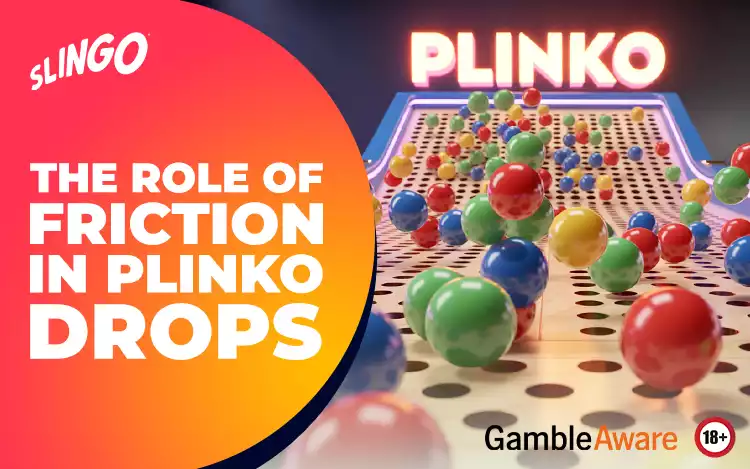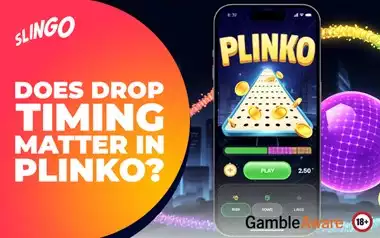From the moment a ball begins its journey down the Plinko board, physics quietly takes the lead. One force in particular—friction in Plinko—plays a surprisingly important role in shaping the motion, bounce, and final destination of the ball.
In this article, we’ll look at how friction influences each drop, whether you’re watching a physical board or enjoying a digital version on Slingo.com. We’ll explore the science behind every bounce, how friction changes ball behaviour, and what this all means in an online game setting where outcomes are powered by RNG (Random Number Generators).
Understanding these elements is part of appreciating how Plinko works, and why the game remains such a favourite for players who enjoy an element of unpredictability and visual excitement.
What Is Friction, and Why Does It Matter in Plinko?
Friction is the resistance that occurs when two surfaces come into contact. In online Plinko, this refers to the interaction between the ball and the board’s components—such as pegs, walls, and the surface itself.
While gravity pulls the ball downward, friction can slow it slightly, redirect its bounce, or even change the speed of its descent. It’s one of the many reasons no two drops are ever exactly the same.
How Friction Affects Plinko Ball Movement
Slowing the Drop
Each time the ball makes contact with a peg, it loses a small amount of speed. This is due to energy being absorbed through friction. On a physical board, you might notice some drops appear to move slower, bounce higher, or even cling to a path for longer than others, all thanks to variations in friction.
In the digital version on Slingo, this natural variability is visually simulated while the final result is determined by RNG behind the scenes.
Altering the Angle of Bounce
Friction also influences the direction a ball takes after impact. A smooth surface may produce a consistent bounce, while a more textured peg or a different angle might nudge the ball off in an unexpected direction.
Though these differences are subtle, they help create the randomness that defines the Plinko experience.
Changing Descent Patterns
On a larger scale, friction can alter the entire path the ball takes down the board. Slower drops tend to interact with more pegs, resulting in more side-to-side movement. This increased unpredictability contributes to the final landing being truly random—especially when combined with the shape and spacing of the pegs.
Friction in Online Plinko Games
Simulated Physics vs Real Physics
In physical Plinko, friction is an organic part of the gameplay. But in digital Plinko games—like those on Slingo.com—real-world physics are transformed into visual effects, while outcome mechanics rely on algorithms.
Friction is still “there,” in a sense—it’s just not influencing the result. Instead, it’s used as part of the game animation to replicate the familiar path and feel of a traditional Plinko drop. This ensures that even though RNG is determining where the ball lands, the journey looks realistic and satisfying.
RNG Ensures Fairness
Since friction doesn’t affect the actual outcome in online Plinko, players can rest assured that each drop is governed by fairness and chance. The RNG system ensures results are unbiased, meaning no one can predict or manipulate where the ball will land based on visual cues like speed or angle.
It’s an important part of why digital Plinko remains so engaging—it captures the look and feel of real physics while staying grounded in controlled randomness.
Can Friction Be Predicted or Used Strategically?
The Allure of Pattern Spotting
Some players may find themselves watching closely, trying to pick up on patterns—was that drop slower? Did that bounce look different? In a physical game, friction might vary slightly from one drop to another, especially if the board is worn or uneven.
But in digital games, where visuals are consistent and outcomes are RNG-driven, friction can’t be used as a strategy. Even if one ball appears to bounce differently, the underlying result was already determined the moment the ball was released.
It's All About Luck
At Slingo, we always remind players that wins are not guaranteed. Every drop is random, and even though friction is part of the visual experience, it doesn’t mean there’s a “better” way to play. In the end, Plinko is all about luck, not tactics.
Slingo’s Realistic Plinko Animations
Why Visual Details Matter
Just because friction doesn’t influence results doesn’t mean it isn’t important. Slingo takes care to make sure each digital drop mirrors what you’d expect from a physical board. The ball bounces off pegs, slows down slightly, and finds its way to a final slot—just like in classic Plinko.
These small visual details are what make online Plinko feel authentic and enjoyable, helping players stay connected to the classic version of the game.
Friction in Animation vs Function
In Slingo’s version of Plinko, the animated path of the ball is just that—animated. The function (or final outcome) is determined separately by the RNG. This separation helps ensure fairness while keeping the game visually dynamic and familiar.
The Science Behind the Scenes
Peg Material, Ball Texture, and Friction
In real-world physics, the amount of friction depends on the materials in contact. A rubber ball bouncing on a metal peg will behave differently from a plastic ball on a wooden board. These elements affect the way friction slows or redirects movement.
In digital Plinko, this kind of scientific accuracy is reflected in the programming. While actual material resistance doesn’t exist, the game’s motion is designed to mimic the kinds of paths that friction would create in real life.
It’s one of the ways Slingo ensures a balance between realism and fairness, even in an RNG-controlled environment.
Final Thoughts: Friction Adds to the Magic, Not the Outcome
So, does friction in Plinko matter? Yes—and no. In physical games, it influences how the ball moves, bounces, and lands. In online games, it’s part of the animation but doesn’t determine the result.
Whether you’re playing on a real board or dropping balls on Slingo.com, friction adds to the visual and physical charm of the game. It’s part of what makes each drop feel unique, even if the final outcome is left up to luck. That’s the beauty of Plinko—it’s simple, engaging, and powered by randomness.








